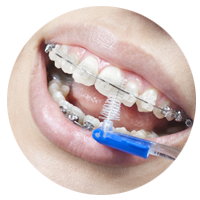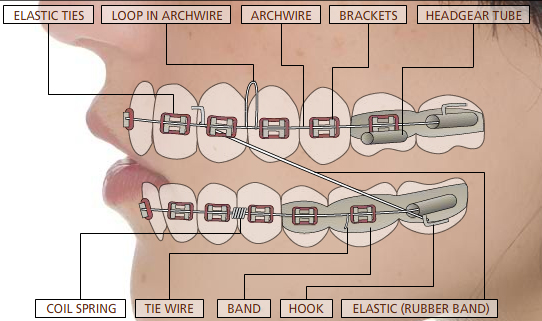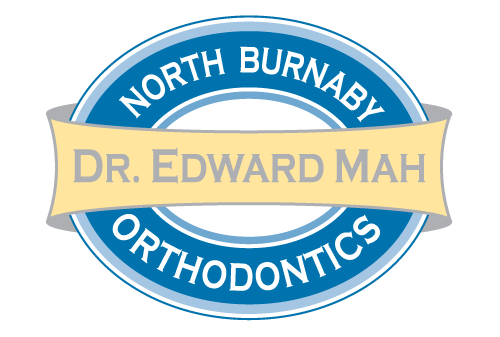Your Braces

Caring for Your Braces
Dr. Mah advises his patients to eat soft food for a week after braces are bonded. After that, you can eat just about anything you want, but you need to be careful! There are some things that you should try and avoid, as they can knock off your braces!
Occasionally, through the treatment, you might experience some degree of discomfort. For relief, you may use pain relievers that you would take when you have headaches. Or, you may rinse your mouth with a mixture of 1 teaspoon of salt and 1 cup of warm water.
Hard fruits and vegetables need to be cut into small, bite-sized pieces first. Pens, pencils and foreign objects need to be kept out of the mouth. If you can avoid these hazards, you will be on your way to completing the treatment goals on time! CUT UP foods like pizza, apples, raw vegetables, steak, corn on the cob, ribs or chicken before you eat.
Dr. Mah encourages all of his patients to follow these guidelines for maximum oral health. Always remember to brush your teeth and braces after every meal and snack!
Even some small snacks can cause stains on teeth if you don’t remove food particles properly from your braces. Rinsing your mouth with water to loosen food particles may help, if you are unable to brush your teeth right away.
Be sure to visit your family dentist every 6 months for a dental cleaning to ensure oral hygiene, and to prevent cavities!
Avoid
- Hard candy, like Jolly Ranchers, Lifesavers, Starbursts or Jaw Breakers.
- Hard snacks, like popcorn, tortilla chips, nuts and hard granola bars.
- Soft candy, like gummy bears, caramel and taffy.
- Soft snacks, like jerky or pepperoni sticks.
- Eating hard taco shells, pizza crusts and French bread crusts.
Quick Tips
- Do not eat foods that are hard, sticky, crunchy or chewy.
Avoid gum, candy and nuts. - Cut raw vegetables and fruits into small pieces.
- Do not pick at or pull your braces even if it makes you feel better.
- Do not flick your retainer around with your tongue.
- Wear a mouth guard when playing sports.
- Learn as much as you can about your orthodontic appliances. This will help you talk to us about any problems you may have.
- Always keep some orthodontic wax handy and carry a travel toothbrush.

Still unsure of a term?
If you’re still unsure of a term, click below for a list of terms used in orthodontics.
Parts Of Your Braces
| Appliance | Anything that your orthodontist attaches to your teeth in order to make it move, or to change the shape of your jaw. |
| Archwire | A metal wire attached to your brackets in order to move your teeth. |
| Bracket | A metal or ceramic part that is glued to a tooth and used to fasten the archwire |
| Chain | Also known as orthodontic chain. It is a stretchable plastic chain used to hold archwires into brackets, move teeth and close spaces. |
| Donut | A small plastic ring which is used to hold the archwires in the brackets on your teeth. |
| Mouthguard | A device used to protect your mouth and teeth from injury from sports. |
| Palatal Expander | Removable or non-removable device used to make your upper jaw wider. |
| Retainer | An appliance that you are given to wear after your braces are removed. A retainer is designed to hold teeth in the correct position. |
| Separator | A small rubber ring used to create space between your back teeth for bands. |
| Wax | Used to prevent your braces from irritating your lips and the inside of your mouth. |
Procedure Definitions
| Banding | The process of gluing orthodontic bands to your teeth. | |
| Bonding | Process of attaching brackets to your teeth using special orthodontic glue. | |
| Debanding | The process of removing orthodontic bands from your teeth. | |
| Debonding | The process of removing orthodontic brackets from your teeth. | |
| Impressions | Used to make models of your teeth by having you bite into a tray filled with alginate, a substance that hardens to produce molds. | |
| Ligation | A process where an archwire is attached to the brackets on your teeth. | |
| Panoramic X-Ray | X-rays taken by a machine that revolves around your head | |
| Wax Bite | Procedure used to measure how well your teeth come together. |
Emergencies
If you have any emergencies, please visit this page.
